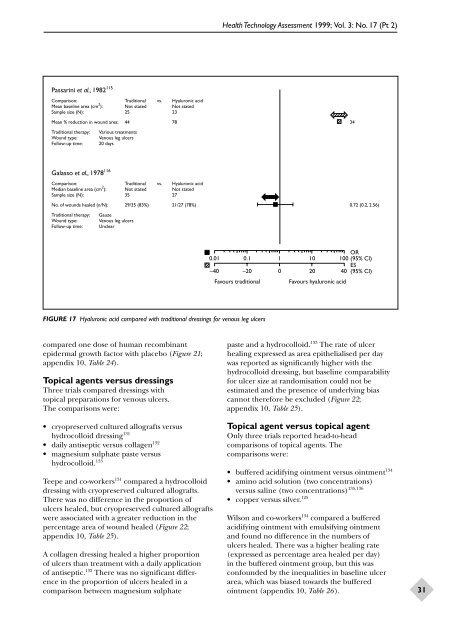Dressings and Topical Agents for Chronic Wounds - NIHR Health ...
Dressings and Topical Agents for Chronic Wounds - NIHR Health ...
Dressings and Topical Agents for Chronic Wounds - NIHR Health ...
Create successful ePaper yourself
Turn your PDF publications into a flip-book with our unique Google optimized e-Paper software.
<strong>Health</strong> Technology Assessment 1999; Vol. 3: No. 17 (Pt 2)Passarini et al., 1982 115Comparison: Traditional vs. Hyaluronic acidMean baseline area (cm 2 ): Not stated Not statedSample size (N): 25 23Mean % reduction in wound area: 44 78 34Traditional therapy: Various treatmentsWound type: Venous leg ulcersFollow-up time: 20 daysGalasso et al., 1978 116Comparison: Traditional vs. Hyaluronic acidMedian baseline area (cm 2 ): Not stated Not statedSample size (N): 35 27No. of wounds healed (n/N): 29/35 (83%) 21/27 (78%) 0.72 (0.2, 2.56)Traditional therapy: GauzeWound type: Venous leg ulcersFollow-up time: Unclear0.01 0.1 1 10 100 OR(95% CI)–40 –20 0 20 40 ES(95% CI)Favours traditionalFavours hyaluronic acidFIGURE 17 Hyaluronic acid compared with traditional dressings <strong>for</strong> venous leg ulcerscompared one dose of human recombinantepidermal growth factor with placebo (Figure 21;appendix 10, Table 24).<strong>Topical</strong> agents versus dressingsThree trials compared dressings withtopical preparations <strong>for</strong> venous ulcers.The comparisons were:• cryopreserved cultured allografts versushydrocolloid dressing 131• daily antiseptic versus collagen 132• magnesium sulphate paste versushydrocolloid. 133Teepe <strong>and</strong> co-workers 131 compared a hydrocolloiddressing with cryopreserved cultured allografts.There was no difference in the proportion ofulcers healed, but cryopreserved cultured allograftswere associated with a greater reduction in thepercentage area of wound healed (Figure 22;appendix 10, Table 25).A collagen dressing healed a higher proportionof ulcers than treatment with a daily applicationof antiseptic. 132 There was no significant differencein the proportion of ulcers healed in acomparison between magnesium sulphatepaste <strong>and</strong> a hydrocolloid. 133 The rate of ulcerhealing expressed as area epithelialised per daywas reported as significantly higher with thehydrocolloid dressing, but baseline comparability<strong>for</strong> ulcer size at r<strong>and</strong>omisation could not beestimated <strong>and</strong> the presence of underlying biascannot there<strong>for</strong>e be excluded (Figure 22;appendix 10, Table 25).<strong>Topical</strong> agent versus topical agentOnly three trials reported head-to-headcomparisons of topical agents. Thecomparisons were:• buffered acidifying ointment versus ointment 134• amino acid solution (two concentrations)versus saline (two concentrations) 135,136• copper versus silver. 125Wilson <strong>and</strong> co-workers 134 compared a bufferedacidifying ointment with emulsifying ointment<strong>and</strong> found no difference in the numbers ofulcers healed. There was a higher healing rate(expressed as percentage area healed per day)in the buffered ointment group, but this wasconfounded by the inequalities in baseline ulcerarea, which was biased towards the bufferedointment (appendix 10, Table 26).31
















